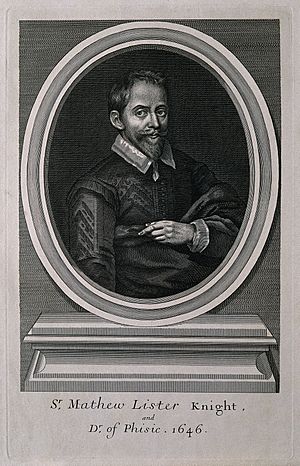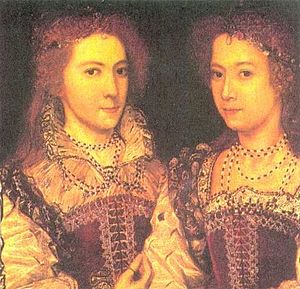Matthew Lister (died 1657) facts for kids
Matthew Lister (died 1657) was a famous doctor who worked for the English royal family. He was also known for his close connection with the Countess of Pembroke.
Contents
Becoming a Doctor
Matthew Lister was born in Thornton in Craven, Yorkshire. His father was William Lister and his mother was Anne Mydhope. As a younger son, Matthew went to Oriel College, Oxford to study. He learned how to practice medicine in Basel, a city in Switzerland.
A later doctor, Edward Wilmot, said that Lister made important progress in medicine. Many people used his medical recipes. Some of his special recipes were collected by Hans Sloane and can still be seen today at the British Library. These old recipes are mostly in Latin and use a simple code for some words.
From 1607, Lister became a fellow of the College of Physicians in London. This meant he was a respected member of the medical community. People, especially wealthy landowners, often wrote to him or visited him in Yorkshire to ask for his medical advice.
Travels in Europe
In 1610 and 1611, Lister went on a big trip called a Grand Tour with John Finet. They traveled with Lord Cranborne, who was the son of a very important person, Sir Robert Cecil. They visited France and Italy.
While in Padua, Italy, Lord Cranborne became sick. Lister took care of him. Cranborne had a fever and felt sad, wanting to go back to England. The group had special permission to travel through certain areas like the Papal States and Bologna to Florence. This was unusual because Protestants were not always allowed to use these routes. It's thought that Cosimo II de' Medici, Grand Duke of Tuscany helped get this permission. This was because talks were happening about a possible marriage between Prince Henry of England and Cosimo's sister, Caterina de' Medici.
Lord Cranborne couldn't be convinced to continue to Tuscany. After visiting Dudley Carleton and enjoying the Venice Carnival, they returned home. They traveled along the Rhine River, saw Amsterdam, The Hague, and Vlissingen. They then sailed from Calais, France, back to England in April 1611.
During this trip, Lister likely met Mark Belford, an English diplomat. Belford later gave Lister a valuable anatomy book by Andreas Vesalius. In 1612, Lister and another doctor, Théodore de Mayerne, treated Robert Cecil during his final illness.
Working with the Countess of Pembroke
Matthew Lister also worked for Mary Sidney, Countess of Pembroke, who passed away in 1621. He traveled with her to Spa, Belgium, a town known for its healing waters. In September 1614, they were in Antwerp with Bridget Parham. They thought about going to Breda or staying with William Trumbull in Brussels. Lister wrote that the Countess continued her "spa diet," which meant she was following a health plan using the spa waters. They were in Amiens, France, in November 1614. Letters for the Countess were sent to Lister, and he helped arrange money and credit through English diplomats.
In 1616, Dudley Carleton met the Countess at Spa. She was with Helene de Melun, the "Countess of Berlaymont." The two women had fun shooting pistols. There were rumors that Mary Sidney had married Lister after her husband died. At that time, she was building a lodge at Houghton. Lister and Leonard Welstead were in charge of the Countess's property. They had obtained Houghton from Sir Edward Conquest in 1615.
In April 1617, John Chamberlain wrote that there was "a suspicion that the olde countesse of Pembroke is married to Doctor Lister." This shows that many people believed the rumors. The writer Lady Mary Wroth might have even written about their relationship in her play Love's Victory. Years later, in 1640, a friend of Mary Sidney, Nathan Walworth, left Lister £10 in his will. He also left him a picture of the town of Spa and a painting of Philoclea and Pamela. These were two main characters from Philip Sidney's famous book, Arcadia.
Royal Physician
Lister became one of the doctors who served Anne of Denmark, the Queen. Mary Sidney's brother, Robert Sidney, 1st Earl of Leicester, was in charge of the Queen's household. Lister also treated the famous actor Edward Alleyn.
In 1625, Lister was involved in a discussion about the death of King James at Theobalds. Later, Charles I of England appointed him as his "physician in ordinary." This meant he was one of the King's personal doctors.
He was likely the "Mr Doctor Litster" who looked after Francis Manners, 6th Earl of Rutland during his final illness in 1632. In 1644, Lister and Mayerne traveled to Exeter to attend to Henrietta Maria, the Queen.
Later Life and Family
Matthew Lister married Catherine Fairfax. His second wife was named Anne. He did not have any children. His nephew, Sir Martin Lister of Thorpe Arnold, became his heir. Sir Martin Lister married Susanna Temple (1600–1669).
Matthew Lister was knighted on October 11, 1636, which meant he was given the title "Sir." He passed away in 1657 (or possibly 1656) at his home in Burwell, Lincolnshire. A portrait of him, believed to be by Paul van Somer, was later made into an engraving.



